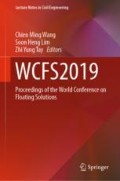Abstract
Concrete is the cheapest construction material and the second most consumed man-maid product after drinking water, which is easily cast to any shape. Concrete technology has evolved very rapidly in recent years and continues to improve with new advancement in construction and materials technology. Early concrete platforms dated to more than 100 years ago with primitive design mixes, materials and construction technique. Since then, many concrete platform have been constructed; some with poor quality and some with very reasonable performance. However, generally the concrete platforms were more durable when compared to steel structures but they are slower to construct. In the past 30 years, there is a new wave of concrete platforms riding on advancement of concrete and construction technology. The owners of concrete platforms now demand for durability design of 100 years or more. The construction time is also significantly reduced. In this paper, durability design of floating concrete platforms is discussed, among which is the recent construction of 138 m × 46 m concrete drydock built for Marisco Ltd. with a lifting capacity of 9500 tons. As stationary platforms, concrete platforms are more durable, less expensive, safer, and more stable and they require less maintenance as compared to steel platforms. However, structural and durability design as well as construction experience are critical for successful execution.
Access this chapter
Tax calculation will be finalised at checkout
Purchases are for personal use only
References
Mehta, P. K. (1986). Concrete. Structure, properties and materials. Englewood Cliffs, NJ, USA: Prentice-Hall.
Markeset G., & Myrdal, R. (2008). Modelling of reinforcement corrosion in concrete—State of the art, COIN P4 operational service life design SP 4.1 F Service life modelling and prediction COIN Project Report 7.
Zivica, V. (2003). Influence of w/c ratio on rate of chloride induced corrosion of steel reinforcement and its dependence on ambient temperature. Bulletin of Material Science, 26(5), 471–475.
Pang, X. (2015). The effect of water-to-cement ratio on the hydration kinetics of Portland cement at different temperatures. In Proceedings of the 14th International Congress on Cement Chemistry. Beijing, China, https://doi.org/10.13140/rg.2.1.4526.2800.
BS EN 772-11. (2011). Methods of test for masonry units. Determination of water absorption of aggregate concrete, autoclaved aerated concrete, manufactured stone and natural stone masonry units due to capillary action and the initial rate of water absorption of clay masonry units, BSI. ISBN: 9780580702587.
Shaikh, F. U. A. (2018). Effect of cracking on corrosion of steel in concrete. International Journal of Concrete Structures and Materials, 12(3). https://doi.org/10.1186/s40069-018-0234-y.
Ghourchian, S., et al. (2017). A practical approach for reducing the risk of plastic shrinkage cracking of concrete. RILEM Technical Letters, 2, 40–44.
Nangy, N., et al. (2013). Crack-free concrete, shrinkage-compensating concrete for the European construction industry. European Coating Journal, 11.
ACI 318-14. (2014). Building code requirements for structural concrete (ACI 318-14) commentary on building code requirements for structural concrete (ACI 318R-14). Reported by ACI Committee 318.
ASTM C1202. (2018). Standard test method for electrical indication of concrete’s ability to resist chloride ion penetration. Developed by Subcommittee: C09.66.
NT Built 492. (1999). Concrete, mortar and cement-based repair: chloride migration coefficient from non-steady-state migration experiments. UDC 691.32/691.53/691.54.
222R-01. (2010). Protection of metals in concrete against corrosion. ACI Committee 222.
Author information
Authors and Affiliations
Corresponding author
Editor information
Editors and Affiliations
Rights and permissions
Copyright information
© 2020 Springer Nature Singapore Pte Ltd.
About this paper
Cite this paper
Sabet Divsholi, B. (2020). Durability of Floating Concrete Platforms. In: Wang, C., Lim, S., Tay, Z. (eds) WCFS2019. Lecture Notes in Civil Engineering , vol 41. Springer, Singapore. https://doi.org/10.1007/978-981-13-8743-2_15
Download citation
DOI: https://doi.org/10.1007/978-981-13-8743-2_15
Published:
Publisher Name: Springer, Singapore
Print ISBN: 978-981-13-8742-5
Online ISBN: 978-981-13-8743-2
eBook Packages: EngineeringEngineering (R0)

